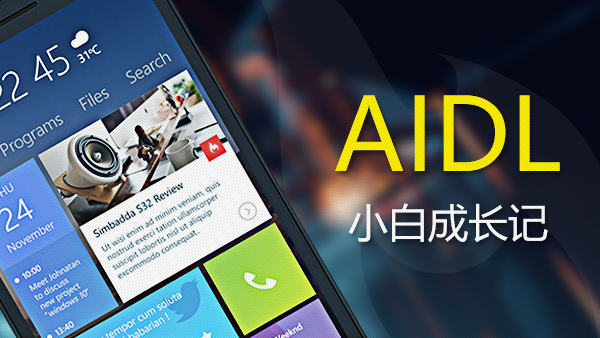全面总结Android Service的使用方法,具体内容如下
1、Service的种类
按运行地点分类:
其实remote服务还是很少见的,并且一般都是系统服务。
按运行类型分类:
有同学可能会问,后台服务我们可以自己创建 ONGOING 的 Notification 这样就成为前台服务吗?答案是否定的,前台服务是在做了上述工作之后需要调用 startForeground ( android 2.0 及其以后版本 )或 setForeground (android 2.0 以前的版本)使服务成为 前台服务。这样做的好处在于,当服务被外部强制终止掉的时候,ONGOING 的 Notification 任然会移除掉。
按使用方式分类:
以上面三种方式启动的服务其生命周期也有区别,将在随后给出。
2、Service 与 Thread 的区别
很多时候,你可能会问,为什么要用 Service,而不用 Thread 呢,因为用 Thread 是很方便的,比起 Service 也方便多了,下面我详细的来解释一下。
1). Thread:Thread 是程序执行的最小单元,它是分配CPU的基本单位。可以用 Thread 来执行一些异步的操作。
2). Service:Service 是android的一种机制,当它运行的时候如果是Local Service,那么对应的 Service 是运行在主进程的 main 线程上的。如:onCreate,onStart 这些函数在被系统调用的时候都是在主进程的 main 线程上运行的。如果是Remote Service,那么对应的 Service 则是运行在独立进程的 main 线程上。因此请不要把 Service 理解成线程,它跟线程半毛钱的关系都没有!
既然这样,那么我们为什么要用 Service 呢?其实这跟 android 的系统机制有关,我们先拿 Thread 来说。Thread 的运行是独立于 Activity 的,也就是说当一个 Activity 被 finish 之后,如果你没有主动停止 Thread 或者 Thread 里的 run 方法没有执行完毕的话,Thread 也会一直执行。因此这里会出现一个问题:当 Activity 被 finish 之后,你不再持有该 Thread 的引用。另一方面,你没有办法在不同的 Activity 中对同一 Thread 进行控制。
举个例子:如果你的 Thread 需要不停地隔一段时间就要连接服务器做某种同步的话,该 Thread 需要在 Activity 没有start的时候也在运行。这个时候当你 start 一个 Activity 就没有办法在该 Activity 里面控制之前创建的 Thread。因此你便需要创建并启动一个 Service ,在 Service 里面创建、运行并控制该 Thread,这样便解决了该问题(因为任何 Activity 都可以控制同一 Service,而系统也只会创建一个对应 Service 的实例)。
因此你可以把 Service 想象成一种消息服务,而你可以在任何有 Context 的地方调用 Context.startService、Context.stopService、Context.bindService,Context.unbindService,来控制它,你也可以在 Service 里注册 BroadcastReceiver,在其他地方通过发送 broadcast 来控制它,当然这些都是 Thread 做不到的。
3、Service的生命周期
onCreate onStart onDestroy onBind
1). 被启动的服务的生命周期:如果一个Service被某个Activity 调用 Context.startService 方法启动,那么不管是否有Activity使用bindService绑定或unbindService解除绑定到该Service,该Service都在后台运行。如果一个Service被startService 方法多次启动,那么onCreate方法只会调用一次,onStart将会被调用多次(对应调用startService的次数),并且系统只会创建Service的一个实例(因此你应该知道只需要一次stopService调用)。该Service将会一直在后台运行,而不管对应程序的Activity是否在运行,直到被调用stopService,或自身的stopSelf方法。当然如果系统资源不足,android系统也可能结束服务。
2). 被绑定的服务的生命周期:如果一个Service被某个Activity 调用 Context.bindService 方法绑定启动,不管调用 bindService 调用几次,onCreate方法都只会调用一次,同时onStart方法始终不会被调用。当连接建立之后,Service将会一直运行,除非调用Context.unbindService 断开连接或者之前调用bindService 的 Context 不存在了(如Activity被finish的时候),系统将会自动停止Service,对应onDestroy将被调用。
3). 被启动又被绑定的服务的生命周期:如果一个Service又被启动又被绑定,则该Service将会一直在后台运行。并且不管如何调用,onCreate始终只会调用一次,对应startService调用多少次,Service的onStart便会调用多少次。调用unbindService将不会停止Service,而必须调用 stopService 或 Service的 stopSelf 来停止服务。
4). 当服务被停止时清除服务:当一个Service被终止(1、调用stopService;2、调用stopSelf;3、不再有绑定的连接(没有被启动))时,onDestroy方法将会被调用,在这里你应当做一些清除工作,如停止在Service中创建并运行的线程。
特别注意:
1、你应当知道在调用 bindService 绑定到Service的时候,你就应当保证在某处调用 unbindService 解除绑定(尽管 Activity 被 finish 的时候绑定会自 动解除,并且Service会自动停止);
2、你应当注意 使用 startService 启动服务之后,一定要使用 stopService停止服务,不管你是否使用bindService;
3、同时使用 startService 与 bindService 要注意到,Service 的终止,需要unbindService与stopService同时调用,才能终止 Service,不管 startService 与 bindService 的调用顺序,如果先调用 unbindService 此时服务不会自动终止,再调用 stopService 之后服务才会停止,如果先调用 stopService 此时服务也不会终止,而再调用 unbindService 或者 之前调用 bindService 的 Context 不存在了(如Activity 被 finish 的时候)之后服务才会自动停止;
4、当在旋转手机屏幕的时候,当手机屏幕在“横”“竖”变换时,此时如果你的 Activity 如果会自动旋转的话,旋转其实是 Activity 的重新创建,因此旋转之前的使用 bindService 建立的连接便会断开(Context 不存在了),对应服务的生命周期与上述相同。
5、在 sdk 2.0 及其以后的版本中,对应的 onStart 已经被否决变为了 onStartCommand,不过之前的 onStart 任然有效。这意味着,如果你开发的应用程序用的 sdk 为 2.0 及其以后的版本,那么你应当使用 onStartCommand 而不是 onStart。
4、startService 启动服务
想要用 startService 启动服务,不管Local 还是 Remote 我们需要做的工作都是一样简单。当然要记得在 Androidmanifest.xml 中注册 service。
根据上面的生命周期,我们便会给出 Service 中的代码框架:
package com.newcj.test; import android.app.Service;import android.content.Intent;import android.os.IBinder; public class LocalService1 extends Service { /** * onBind 是 Service 的虚方法,因此我们不得不实现它。 * 返回 null,表示客服端不能建立到此服务的连接。 */ @Override public IBinder onBind(Intent intent) { return null; } @Override public void onCreate() { super.onCreate(); } @Override public void onStart(Intent intent, int startId) { super.onStart(intent, startId); } @Override public void onDestroy() { super.onDestroy(); } } |
对应生命周期系统回调函数上面已经说明,在对应地方加上适当的代码即可。下面是启动与停止 Service 的代码:
| 12345 | // 启动一个 ActivitystartActivity(new Intent(this, LocalService1.class));...// 停止一个 ActivitystopService(new Intent(this, LocalService1.class)); |
对应的 Intent 为标志服务类的 Intent。
5、Local 与 Remote 服务绑定
同样记得在 Androidmanifest.xml 中注册 service
1). Local 服务绑定:Local 服务的绑定较简单,首先在 Service 中我们需要实现 Service 的抽象方法 onBind,并返回一个实现 IBinder 接口的对象。
Service 中的代码:
package com.newcj.test; import android.app.Service;import android.content.Intent;import android.os.Binder;import android.os.IBinder; public class LocalService extends Service { /** * 在 Local Service 中我们直接继承 Binder 而不是 IBinder,因为 Binder 实现了 IBinder 接口,这样我们可以少做很多工作。 * @author newcj */ public class SimpleBinder extends Binder{ /** * 获取 Service 实例 * @return */ public LocalService getService(){ return LocalService.this; } public int add(int a, int b){ return a + b; } } public SimpleBinder sBinder; @Override public void onCreate() { super.onCreate(); // 创建 SimpleBinder sBinder = new SimpleBinder(); } @Override public IBinder onBind(Intent intent) { // 返回 SimpleBinder 对象 return sBinder; } } |
上面的代码关键之处,在于 onBind(Intent) 这个方法 返回了一个实现了 IBinder 接口的对象,这个对象将用于绑定Service 的 Activity 与 Local Service 通信。下面是 Activity 中的代码:
package com.newcj.test; import android.app.Activity;import android.content.ComponentName;import android.content.Context;import android.content.Intent;import android.content.ServiceConnection;import android.os.Bundle;import android.os.IBinder;import android.util.Log;import android.view.View;import android.view.View.OnClickListener; public class Main extends Activity { private final static String TAG = "SERVICE_TEST"; private ServiceConnection sc; private boolean isBind; @Override public void onCreate(Bundle savedInstanceState) { super.onCreate(savedInstanceState); setContentView(R.layout.main); sc = new ServiceConnection() { @Override public void onServiceDisconnected(ComponentName name) { } @Override public void onServiceConnected(ComponentName name, IBinder service) { LocalService.SimpleBinder sBinder = (LocalService.SimpleBinder)service; Log.v(TAG, "3 + 5 = " + sBinder.add(3, 5)); Log.v(TAG, sBinder.getService().toString()); } }; findViewById(R.id.btnBind).setOnClickListener(new OnClickListener() { @Override public void onClick(View v) { bindService(new Intent(Main.this, LocalService.class), sc, Context.BIND_AUTO_CREATE); isBind = true; } }); findViewById(R.id.btnUnbind).setOnClickListener(new OnClickListener() { @Override public void onClick(View v) { if(isBind){ unbindService(sc); isBind = false; } } }); }} |
在 Activity 中,我们通过 ServiceConnection 接口来取得建立连接 与 连接意外丢失的回调。bindService有三个参数,第一个是用于区分 Service 的Intent 与 startService 中的 Intent 一致,第二个是实现了 ServiceConnection 接口的对象,最后一个是 flag 标志位。有两个flag,BIND_DEBUG_UNBIND 与 BIND_AUTO_CREATE,前者用于调试(详细内容可以查看javadoc 上面描述的很清楚),后者默认使用。unbindService 解除绑定,参数则为之前创建的 ServiceConnection 接口对象。另外,多次调用 unbindService 来释放相同的连接会抛出异常,因此我创建了一个 boolean 变量来判断是否 unbindService 已经被调用过。
2). Remote 服务绑定:Remote 的服务绑定由于服务是在另外一个进程,因此需要用到 android 的 IPC 机制。这将又是一个很长的话题,因此,我打算写另外一篇 android 的 IPC 机制分析 ,并在其中进行详述,然后在这里更新链接,敬请关注。
特别注意:
1、Service.onBind如果返回null,则调用 bindService 会启动 Service,但不会连接上 Service,因此 ServiceConnection.onServiceConnected 不会被调用,但你任然需要使用 unbindService 函数断开它,这样 Service 才会停止。
6、创建前台服务
前台服务的优点上面已经说明,但设置服务为前台服务,我们需要注意在 sdk 2.0 及其以后版本使用的方法是 startForeground 与 stopForeground,之前版本使用的是 setForeground ,因此如果你应用程序的最低运行环境要求是 2.0,那么这里可以直接运用新方法,如果运行环境是2.0以下,那么为了保证向后兼容性,这里必须使用反射技术来调用新方法。
下面是我仿照 ApiDemos 重新敲的代码,对某些地方进行了修改,因此更具有说明性:
package com.newcj.test; import java.lang.reflect.InvocationTargetException;import java.lang.reflect.Method; import android.app.Notification;import android.app.NotificationManager;import android.app.PendingIntent;import android.app.Service;import android.content.Context;import android.content.Intent;import android.os.IBinder; public class ForegroundService extends Service { private static final Class[] mStartForegroundSignature = new Class[] { int.class, Notification.class}; private static final Class[] mStopForegroundSignature = new Class[] { boolean.class}; private NotificationManager mNM; private Method mStartForeground; private Method mStopForeground; private Object[] mStartForegroundArgs = new Object[2]; private Object[] mStopForegroundArgs = new Object[1]; @Override public IBinder onBind(Intent intent) { return null; } @Override public void onCreate() { super.onCreate(); mNM = (NotificationManager)getSystemService(Context.NOTIFICATION_SERVICE); try { mStartForeground = ForegroundService.class.getMethod("startForeground", mStartForegroundSignature); mStopForeground = ForegroundService.class.getMethod("stopForeground", mStopForegroundSignature); } catch (NoSuchMethodException e) { mStartForeground = mStopForeground = null; } // 我们并不需要为 notification.flags 设置 FLAG_ONGOING_EVENT,因为 // 前台服务的 notification.flags 总是默认包含了那个标志位 Notification notification = new Notification(R.drawable.icon, "Foreground Service Started.", System.currentTimeMillis()); PendingIntent contentIntent = PendingIntent.getActivity(this, 0, new Intent(this, Main.class), 0); notification.setLatestEventInfo(this, "Foreground Service", "Foreground Service Started.", contentIntent); // 注意使用 startForeground ,id 为 0 将不会显示 notification startForegroundCompat(1, notification); } @Override public void onDestroy() { super.onDestroy(); stopForegroundCompat(1); } // 以兼容性方式开始前台服务 private void startForegroundCompat(int id, Notification n){ if(mStartForeground != null){ mStartForegroundArgs[0] = id; mStartForegroundArgs[1] = n; try { mStartForeground.invoke(this, mStartForegroundArgs); } catch (IllegalArgumentException e) { e.printStackTrace(); } catch (IllegalAccessException e) { e.printStackTrace(); } catch (InvocationTargetException e) { e.printStackTrace(); } return; } setForeground(true); mNM.notify(id, n); } // 以兼容性方式停止前台服务 private void stopForegroundCompat(int id){ if(mStopForeground != null){ mStopForegroundArgs[0] = Boolean.TRUE; try { mStopForeground.invoke(this, mStopForegroundArgs); } catch (IllegalArgumentException e) { e.printStackTrace(); } catch (IllegalAccessException e) { e.printStackTrace(); } catch (InvocationTargetException e) { e.printStackTrace(); } return; } // 在 setForeground 之前调用 cancel,因为我们有可能在取消前台服务之后 // 的那一瞬间被kill掉。这个时候 notification 便永远不会从通知一栏移除 mNM.cancel(id); setForeground(false); } } |
特别注意:
1.使用 startForeground ,如果 id 为 0 ,那么 notification 将不会显示。
7、在什么情况下使用 startService 或 bindService 或 同时使用startService 和 bindService
如果你只是想要启动一个后台服务长期进行某项任务那么使用 startService 便可以了。如果你想要与正在运行的 Service 取得联系,那么有两种方法,一种是使用 broadcast ,另外是使用 bindService ,前者的缺点是如果交流较为频繁,容易造成性能上的问题,并且 BroadcastReceiver 本身执行代码的时间是很短的(也许执行到一半,后面的代码便不会执行),而后者则没有这些问题,因此我们肯定选择使用 bindService(这个时候你便同时在使用 startService 和 bindService 了,这在 Activity 中更新 Service 的某些运行状态是相当有用的)。另外如果你的服务只是公开一个远程接口,供连接上的客服端(android 的 Service 是C/S架构)远程调用执行方法。这个时候你可以不让服务一开始就运行,而只用 bindService ,这样在第一次 bindService 的时候才会创建服务的实例运行它,这会节约很多系统资源,特别是如果你的服务是Remote Service,那么该效果会越明显(当然在 Service 创建的时候会花去一定时间,你应当注意到这点)。
8、在 AndroidManifest.xml 里 Service 元素的常见选项
android:name ------------- 服务类名
android:label -------------- 服务的名字,如果此项不设置,那么默认显示的服务名则为类名
android:icon -------------- 服务的图标
android:permission ------- 申明此服务的权限,这意味着只有提供了该权限的应用才能控制或连接此服务
android:process ---------- 表示该服务是否运行在另外一个进程,如果设置了此项,那么将会在包名后面加上这段字符串表示另一进程的名字
android:enabled ---------- 如果此项设置为 true,那么 Service 将会默认被系统启动,不设置默认此项为 false
android:exported --------- 表示该服务是否能够被其他应用程序所控制或连接,不设置默认此项为 false




 随时随地看视频
随时随地看视频




